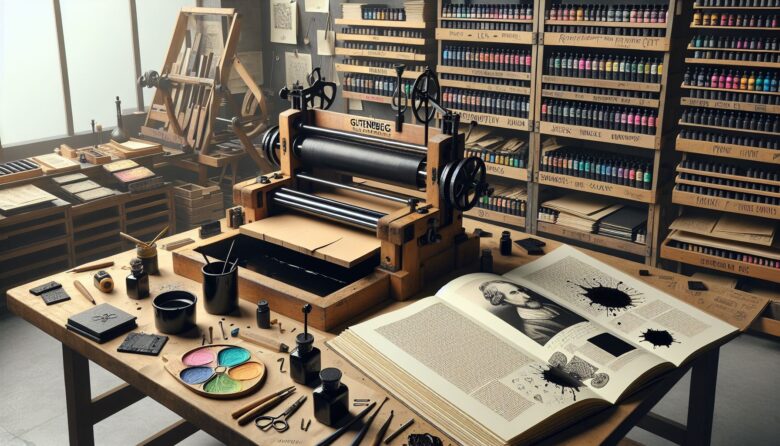Imagine a world without printed materials. No books, no newspapers, no magazines, and no posters adorning the walls. It is impossible to deny the profound impact that printing has had on society and how it has shaped the way we obtain and share information. From Gutenberg’s invention of the printing press to the technological advancements of today, printing has undergone a remarkable evolution. In this blog post, we will delve into the history of printing, explore the various printing methods and technologies that have emerged over time, and examine the impact of printing on society and culture.
The Birth of Printing and the Gutenberg Revolution
Printing, as we know it today, owes its existence to Johannes Gutenberg, a German blacksmith, inventor, and printer, who introduced the movable type printing press in the 15th century. Gutenberg’s invention revolutionized the process of printing, making it faster, more efficient, and more accessible than ever before. With the ability to produce multiple copies of the same text quickly and accurately, the dissemination of knowledge became easier, offering opportunities for education and enlightenment like never before.
From Woodblock to Movable Type
Before Gutenberg’s invention, printing was a laborious and time-consuming process. The earliest form of printing, known as woodblock printing, can be traced back to ancient China, where characters or images were carved onto wooden blocks, inked, and stamped onto paper or fabric. While effective, this method was limited in its ability to reproduce multiple copies of the same text.
Gutenberg’s introduction of movable type printing press marked a significant advancement in the industry. Instead of carving out complete blocks, individual letters and characters could be cast from metal, rearranged, and reused to form different combinations of text. This breakthrough in printing technology not only enabled mass production but also facilitated the spread of ideas and knowledge across Europe and beyond.
The Rise of Industrial Printing
As the demand for printed materials grew, so did the need for more efficient printing methods. The industrial revolution in the late 18th century saw a surge in technological innovation within the printing industry. Steam-powered presses, such as the rotary press, were introduced, enabling much faster printing speeds and higher volumes of production. This transformative shift allowed for the widespread distribution of newspapers, magazines, and books, fueling the dissemination of information and the growth of literacy among the masses.
The Digital Revolution and its Print Implications
With the advent of computers and the internet, the printing industry experienced yet another revolution – the digital revolution. The ability to create, design, and store documents digitally opened up a new realm of possibilities for printing. Printing processes became faster, more precise, and customizable, leading to improvements in quality and versatility. These advancements also enabled the rise of print-on-demand services, allowing for personalized printing and reducing waste by only printing what is needed when it is needed.
However, the digital revolution hasn’t come without its challenges for the printing industry. With the rise of e-books, online news consumption, and digital advertising, there has been a shift towards digital content consumption. This has had a direct impact on the demand for printed materials, particularly in the newspaper and magazine sectors. Nonetheless, the printing industry has proven its resilience and adaptability by finding new niches and markets, such as high-quality art prints and limited edition books sought after by collectors.
The Impact of Printing on Society and Culture
Printing has undoubtedly shaped society and culture in profound ways. Here are just a few of the impacts that printing has had over the centuries:
Education and Literacy
The printing press made books more accessible and affordable, opening up opportunities for education and literacy. The spread of knowledge through printed materials paved the way for greater intellectual and cultural advancements, empowering individuals and societies.
Information Sharing and the Enlightenment
Printing played a crucial role in the dissemination of information during the Enlightenment period. It allowed for the exchange of ideas, the critique of authority, and the advancement of scientific knowledge. The printing press acted as a catalyst for social change and the questioning of established norms and beliefs.
Preservation of Knowledge and History
Printing has played a crucial role in preserving our history and cultural heritage. Without printed materials, invaluable works of literature, historical records, and scientific discoveries would have been lost or forgotten over time. Printing has allowed us to cherish and learn from the past, ensuring that knowledge is passed down to future generations.
Cultural and Artistic Expression
Printing has provided a platform for artistic expression, allowing artists to share their creations with a wider audience. From etchings and engravings to lithographs and screen prints, printing techniques have been integral to the art world, enabling the reproduction and dissemination of artistic works that might otherwise be confined to galleries or private collections.
Conclusion
Printing has come a long way since Gutenberg’s invention of the movable type printing press. From woodblock printing to industrial printing, and now the digital revolution, printing has continually evolved to meet the needs of society and technology. Its impact on education, information sharing, and cultural expression cannot be overstated. While the digital age has posed challenges to the industry, printing continues to thrive and adapt, proving its enduring relevance in an ever-changing world. So, the next time you pick up a book or read a newspaper, take a moment to appreciate the rich history and ongoing legacy of the printing industry










